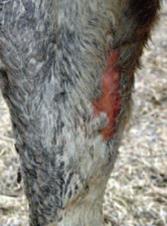Hair loss, lesions and swellings
Why is it measured?
Hair loss, lesions and swellings all demonstrate some form of damage to the skin and in some cases the underlying tissues. Occasional small areas of skin damage/swelling may be inevitable amongst a herd of cattle but areas larger than 2 cm may give reason for concern.
Hairless patches indicate repeated rubbing or irritation, ectoparasite presence or previous injuries (scars). Lesions indicate skin damage and can be as a result of poor management, poor building design/maintenance, damaged gates/fences or cattle interactions. Swellings can be as a result of similar poor building design/maintenance, feed trough/barrier design, abscesses, cysts or injection sites. The location of hair loss, lesions and swellings is important in determining the likely causes of them.
How to assess and score using the AssureWel measure
4. Hair loss, lesions and swellings Individual measure
|
|
Assess the whole herd and tally the number of animals seen with hairless patches ≥ 2cm diameter or lesions ≥ 2cm diameter or swellings ≥ 5cm in diameter anywhere on the body. Comment if hair loss, lesions or swellings are occurring on a particular area of the body within a group and identify which group.
Visually assess from a distance not exceeding 2 m.
|

|

|

|
Hairless patch ≥ 2 cm diameter
|
Lesion ≥ 2 cm diameter
|
Swellings ≥ 5 cm in diameter
|
- Lameness
- Cleanliness
- Body Condition Score (adult cattle only)
- Hairloss, lesions and swellings
- Animals with respiratory signs
- Cattle needing further care
- Disbudding, dehorning and castration
- Mortality